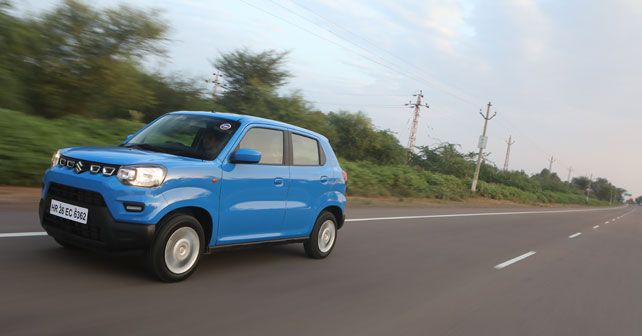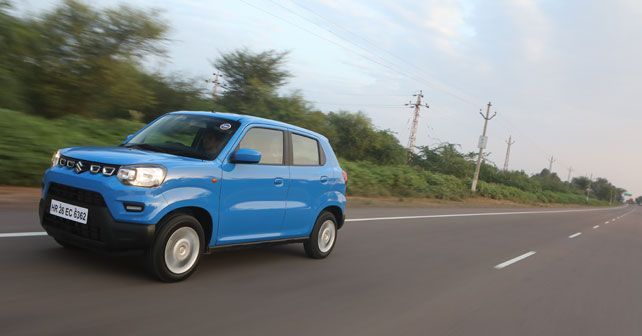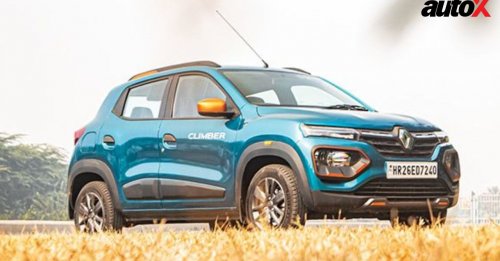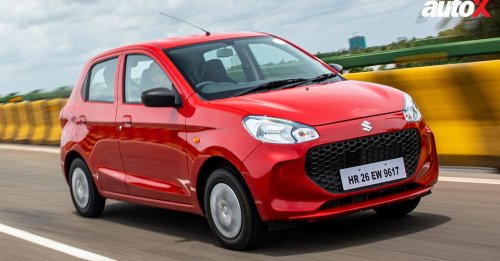
The new S-Presso is Maruti Suzuki’s attempt to give its B Segment hatchback line-up a caffeine-shot in the hope to expand its horizons. But does it have what it takes to follow in the footsteps of the highly successful Alto K10?
Four years ago, when the Renault Kwid hit the market, it grabbed everyone’s attention with its crossover styling, which gave it very strong road presence – stronger than any other entry-level hatchback. Its styling was, in fact, at the core of its success. Of course, the fact that the Kwid was a very spacious car and had the novelty of a touch-screen infotainment system – something that was unheard of in an 800cc car! – also helped.
Four years later, Maruti Suzuki is aiming straight for the Kwid with this, the all-new S-Presso. It’s got tall design lines that gives it better road presence than a traditional hatchback, which consequently means a spacious cabin with plenty of headroom. It’s also wide enough to appear proportionate and, hence, has a good amount of shoulder room for occupants. And, surprise surprise, it has a touchscreen infotainment system too.
Looks matter
Researchers say that design is the single biggest influencing factor in a customer’s buying decision. And while design is a matter of personal taste, there seems to be a general consensus on what’s good and what’s not.
It’s true that the S-Presso’s design has raised some eyebrows. It looks fairly basic on the face of it, and even a bit utilitarian from certain angles. But Maruti Suzuki has an ace up its sleeve, for it offers numerous customisation options for the S-Presso – which allow you to pick and choose not just individual interior and exterior accessories, but also full accessory packs. At ₹26,490, they’re quite affordable too. Also, dual-tone alloy wheels are on offer for an additional `5,590 per piece.
So, what you get is the option to trick out your S-Presso, with exterior body cladding, exterior & interior colour trim inserts, seat covers, and alloy wheels from the numerous options available. And, who knows, the final result may even surprise you!
It’s worth noting that our Pearl Starry Blue test car was fitted with a few accessories, which included LED DRLs, a front grill chrome garnish, and a rear tailgate plastic garnish – all of which is available at a package price of ₹11,990.
Step into the S-Presso, and you’re greeted by a fairly basic all-black interior. On the upside, the plastic quality and seats are on the money. Although, I must add that the interior of the more affordable Alto K10 is more upmarket in terms of appearance and plastic quality.
The top-end VXi+ model comes fitted with remote central locking, front power windows, and Maruti Suzuki’s SmartPlay Studio infotainment system, which offers a raft of smartphone connectivity features that make it very premium for this segment.
There’s no reverse camera here, but do bear in mind that this is a price-sensitive entry-level hatchback. What cannot be overlooked, however, is the lack of a central lock/unlock button. The S-Presso has speed-sensitive automatic door locking, which is good, but until you pull out the key from the ignition, the doors will not unlock. Of course, you can unlock them via the door lock hinges on the door pads, but they’re quite fiddly to operate.
In terms of cabin space, this car is impressive. Even with tall front occupants, there’s just so much rear-seat legroom that you can literally stretch your legs out. The rear seat bench is long, and the seat is high, so you get plenty of under-thigh support, while the backrest has very decent lower-back support. The rear seat headrests, though, are disappointing, as they’re tiny and offer no support whatsoever.
Gem of an engine
For me, the defining factor of the S-Presso is its heart – Suzuki’s K10B petrol engine is a gem of a motor. Its all-aluminium head and block construction make it light and fuel-efficient. And it absolutely loves to rev!
On paper, it develops 67bhp of max power at 5,500rpm and 90Nm of peak torque at 3,500rpm. But it’s the real-world driveability of this engine that never ceases to impress you. Right from the get-go, there’s enough power and, irrespective of the gear that you’re in, the throttle response is always immediate. Step on it, and this engine feels very entertaining in the way it revs. And going higher up the rev range is accompanied by an interesting soundtrack.
The S-Presso does not have a rev counter though. But cars like the K10 and Celerio, which are powered by this very engine, rev past the 6,000rpm mark and the engine continues to punch with all its might. In short, it’s a very, very entertaining and rewarding engine! So much so that it makes the manual S-Presso a whole lot of fun to drive.
The AMT model, meanwhile, brings the comfort and convenience of an automatic transmission to the party, without compromising on fuel efficiency. Both manual and automatic models of the S-Presso have a claimed efficiency figure of 21.7km/l. Now, during the test, the AMT in the S-Presso did feel a little jerky during upshifts and downshifts compared to the Alto K10, which also has the same powertrain. But, having driven the Ignis AMT for some time, I must say that the way to live with this system is to gently lift off the throttle (like you do in a manual car) every time you want an upshift, and the gearbox will immediately comply.
So, it’s a matter of getting used to an AMT – and once you learn to live with it, the benefits of fuel efficiency over other automatics and the low-price differential will make you smile every time. This AMT transmission otherwise is on the money when it comes to driveability, as it holds the right gears, always allows for instant part-throttle acceleration, and has fairly decent kick-down acceleration.
New underpinnings
The S-Presso is built on a new Heartect K platform, which is derived from Suzuki’s Kei cars in Japan. But Maruti Suzuki has had to heavily rework it to make it longer and accommodate the spare wheel compartment. The taller ride height has also required Maruti to put in additional work.
On the whole, this chassis feels really good – it’s well-balanced and fairly rigid and allows you to carry some serious speeds around bends. I say this because we’ve had the opporuntity to drive this car on a racetrack as well, and beyond the body roll generated by the tall springs, it has good grip and stability for a car sitting on 165/70 profile tyres. It’s when you push it to the limit, though, that you sense the compromise created by the narrow track and tall height – let’s just say that if you’re aggressive with it, the body roll will eventually lead to lifting two wheels off the ground if you’re not careful.
Out on the road, though, there are no such problems and straight-line stability is great. Of course, you do feel the body roll around high-speed bends, but, on the whole, the car feels well-balanced and confident from behind the wheel. Fortunately, or unfortunately, I didn’t encounter a single pothole while driving the S-Presso (very strange for India, but Rajasthan does have a reputation for good roads), so I’ll refrain from commenting on ride comfort at this point. Although, the ride did feel a little firm over speed breakers.
Another blockbuster?
On the face of it, the S-Presso’s styling may not appeal to everyone, but those affordable accessories really help to spruce up the entire package. And, once you get past its looks, what you have here is a really capable hatchback that’s very practical, with an incredibly spacious cabin and high ground clearance. Equipment is limited, but you get a very contemporary infotainment system. And once you drive it, there’s simply no going back.
No other car in this segment has such a good engine! Go for the manual model, and you’ll truly enjoy driving it. Go for the automatic model, and you’ll love its convenience, affordability, and fuel efficiency. And since it’s a Maruti Suzuki, needless to say, it’ll run reliably until the end of time and, of course, be very affordable to own throughout.

- Maruti Suzuki S-Presso MT/AMT
Engine: 998cc / 3-Cylinders / 12 valves / SOHC
Fuel: Petrol
Transmission: Front Wheel Drive - 5-Speed Manual/ AMT
Power: 67bhp @ 5,500rpm
Torque: 90Nm @ 3,500rpm
Price: Rs. 3.69 lakh – 4.91 lakh (ex-showroom Delhi)
X-factor: Affordable customisation options can trick out the car.
| Pros
| Cons
|
Also read - Maruti Suzuki S-Presso launched at Rs 3.69 lakh







![Maruti Suzuki S-Presso [2019-2022] Maruti Suzuki S-Presso [2019-2022] Model Image](https://static.autox.com/uploads/cars/2019/09/maruti-suzuki-s-presso-30-sep-2019.jpg)


















Write your Comment